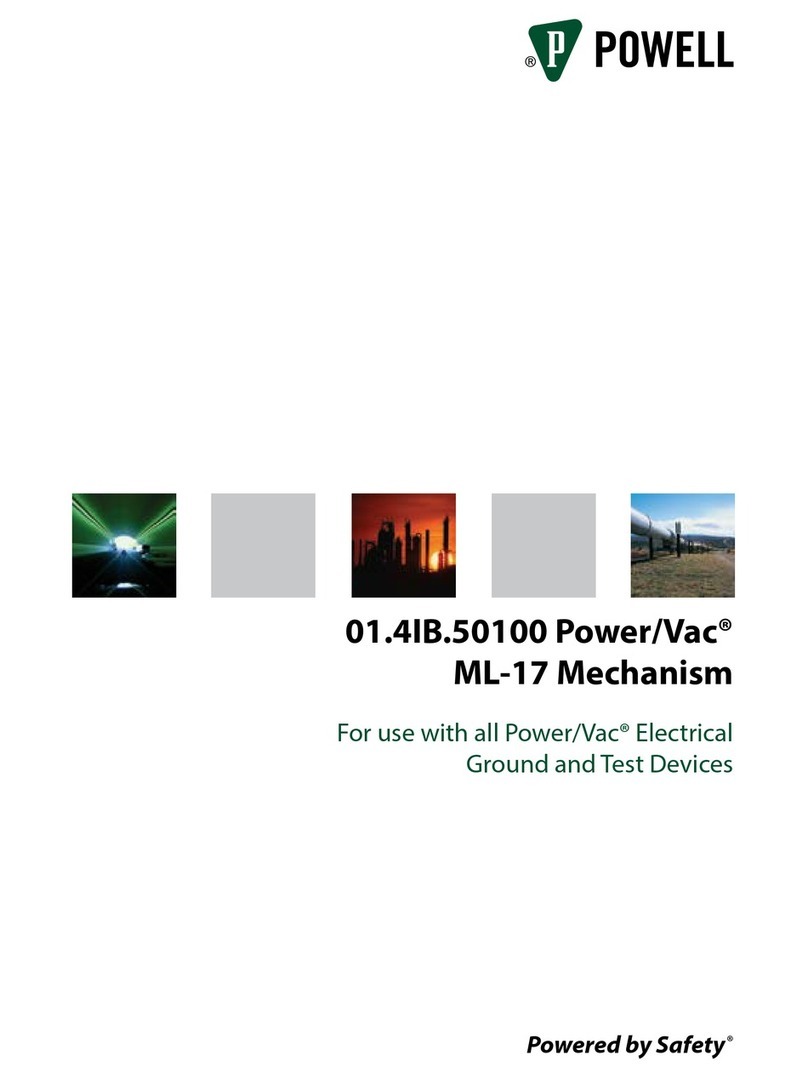
PowlVac®Electrically-Operated Ground and Test Device IB-65060
6
2. The PowlVac®PV 38 Electrically Operated
Ground and Test Device is designed for use in
P-65000 PowlVac®Metal-Clad Switchgear
manufactured by Powell Electrical Manufacturing
Company. Do not attempt to use this device in
any other class of electrical equipment manufac-
tured by Powell or any other manufacturer. This
device is designed to be inserted in a metal-clad
switchgear unit in place of a vacuum circuit
breaker for grounding and testing purposes.
3. Only supervised and qualified personnel who are
trained in the usage, installation, operation, and
maintenance of electrical ground and test device
shall be allowed to work on this equipment. It is
mandatory that this instruction bulletin, any
supplements, and service advisories are studied,
understood, and followed.
4. Maintenance programs must be consistent with
the customer experience and the manufacturer’s
recommendations, including information avail-
able in service advisories and the instruction
bulletin(s). A well-planned and executed routine
maintenance program is essential for the electri-
cal ground and test device reliability and safety.
5. Service conditions and electrical ground and test
device applications shall be considered in the
development of maintenance programs. Service
conditions include variables such as ambient
temperature, humidity, number of operations, and
any adverse local conditions such as excessive
dust, ash, corrosive atmosphere, vermin, and
insect problems.
B. SPECIFIC
When operating the ground and test device safety
precautions must be observed. IMPROPER USE
CAN RESULT IN DEATH, SERIOUS PERSONAL
INJURY, OR DAMAGE TO PROPERTY. It is
important for the user to develop specific and safe
operating procedures to be observed when using the
ground and test device.
The following specific safety precautions MUST be
observed:
1. Do not close the grounding switch on an ener-
gized circuit. The circuit to be grounded should
always be treated as energized until proven
otherwise.
2. Use great care when opening the test port
shutters to gain access to the test receptacles.
The test receptacles should always be treated as
energized circuits until proven otherwise.
3. Any test device plugged into the test receptacles
must be properly rated for the circuit voltage
being tested, and all connections must be prop-
erly insulated.
4. Use only the test probes furnished with the
device to plug anything into the test receptacles.
Use of other plugs may damage the test recep-
tacle or may result in a poor connection which
could be dangerous to the operator and/or
damaging to the equipment.
5. Even through insulated, the test probes must not
be inserted or extracted from energized test
jacks. The test probe insulation is only one part
of a complete line-to-ground insulation system,
and the surface of the test probe may be ener-
gized at a voltage above ground potential when
connected to an energized test jack.
6. Do not attempt to force or bypass any interlocks.
The interlocks are furnished for the safety of the
operator and the protection of the equipment
being tested and the test device. Forcing or
bypassing the interlocks can result in a condition
dangerous to the operator and/or damaging to the
equipment.
7. Do not attempt to service the device while it is
installed in a switchgear cell or on a lift truck. For
service, the device must be located either on the
floor or on a sturdy, level work bench, and
blocked from rolling.
8. For service, the device must be in the OPEN
position and all operating springs must be dis-
charged. These conditions should be verified
before removing any covers or attempting any
service.
9. Store the ground and test device in a clean, dry
area free from dust, dirt, moisture, caustic
atmosphere, and vermin.
10. Keep all insulating surfaces, which include
primary support insulation and insulation barriers,
clean and dry.
11. Check all primary circuit connections to make
certain that they are clean and tight.
12. Take extreme care while using this device to
avoid contacting “live” or “hot” (energized)
terminals.
13. Always OPERATE the grounding switch electri-
cally from the farthest distance with the remote
operating station control switch.





























